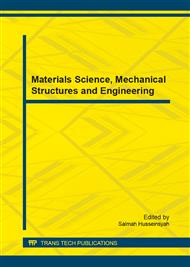p.123
p.127
p.131
p.135
p.140
p.146
p.150
p.154
p.160
Effects of Patch Geometrical Parameters on Mechanical Properties of Damaged Metallic Structure Repaired with Adhesively Bonded Composite Patch
Abstract:
Composite patch adhesively bonded repair is an advanced repairing method for damaged metallic structure, and in patch designing, it is important to choose appropriate geometrical parameters, which decides mechanical properties of repaired structure. Based on 3D FEM, the model of aluminum plate with a central through crack adhesively bonded repaired with carbon/epoxy composite patch was established, which can take into account residual thermal stress and bending deformation caused by differences of thermal expansion coefficient. SIF was calculated using virtual crack closure technology and compared to evaluate effects of patch geometrical parameters on mechanical properties of repaired structure. The results show that there is optimal patch length and thickness which can make best repairing effect and an effective patch width can reduce SIF significantly, beyond which it is helpless.
Info:
Periodical:
Pages:
140-145
Citation:
Online since:
October 2014
Authors:
Price:
Сopyright:
© 2014 Trans Tech Publications Ltd. All Rights Reserved
Share:
Citation:


